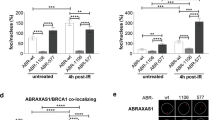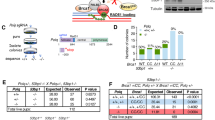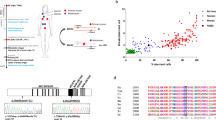Abstract
Germ-line mutations of the BRCA1 and BRCA2 genes, when they lead to a truncated protein, confer a high risk of breast and ovarian cancer. However, the role of BRCA1 missense mutations in cancer predisposition is unclear. Functional assays may be very helpful to more clearly define the biological effect of these mutations, and could therefore be useful in clinical practice. A recent study using a Host Cell End-Joining assay showed that a truncating mutation results in impaired fidelity of DSB repair by DNA end-joining. In the present study, we examined the fidelity of DSB repair in four lymphoblastoid cell lines with BRCA1 missense mutations. The fidelity of DNA end-joining was impaired in the four cell lines studied compared to the normal control cell line. The fidelity of end-joining was similar to that of a truncated mutation control cell line for one cell line and slightly higher for the other cell lines.
This is a preview of subscription content, access via your institution
Access options
Subscribe to this journal
Receive 50 print issues and online access
$259.00 per year
only $5.18 per issue
Buy this article
- Purchase on Springer Link
- Instant access to full article PDF
Prices may be subject to local taxes which are calculated during checkout

Similar content being viewed by others
References
Baldeyron C, Jacquemin E, Smith J, Jacquemont C, De Oliveira I, Gad S, Feunteun J, Stoppa-Lyonnet D and Papadopoulo D . (2002). Oncogene, 21, 1401–1410.
Buchholz TA, Wu X, Hussain A, Tucker SL, Mills GB, Haffty B, Bergh S, Story M, Geara FB and Brock WA . (2002). Int. J. Cancer, 97, 557–561.
Casilli F, Di Rocco ZC, Gad S, Tournier I, Stoppa-Lyonnet D, Frebourg T and Tosi M . (2002). Hum. Mutat., 20, 218–226.
Chen JJ, Silver D, Cantor S, Livingston DM and Scully R . (1999). Cancer Res., 59, 1752s–1756s.
Escarceller M, Buchwald M, Singleton BK, Jeggo PA, Jackson SP, Moustacchi E and Papadopoulo D . (1998). J. Mol. Biol., 279, 375–385.
Fleming MA, Potter JD, Ramirez CJ, Ostrander GK and Ostrander EA . (2003). Proc. Natl. Acad. Sci. USA, 100, 1151–1156.
Foray N, Randrianarison V, Marot D, Perricaudet M, Lenoir G and Feunteun J . (1999). Oncogene, 18, 7334–7342.
Gad S, Caux-Moncoutier V, Pages-Berhouet S, Gauthier-Villars M, Coupier I, Pujol P, Frenay M, Gilbert B, Maugard C, Bignon YJ, Chevrier A, Rossi A, Flicker JP, Nguyen TD, Demange L, Aurias A, Bensimon A and Stoppa-Lyonnet D . (2002). Oncogene, 21, 6841–6847.
Huyton T, Bates PA, Zhang X, Sternberg MJ and Freemont PS . (2000). Mutat. Res., 460, 319–332.
Khanna KK and Jackson SP . (2001). Nat. Genet., 27, 247–254.
Koonin EV, Altschul SF and Bork P . (1996). Nat. Genet., 13, 266–268.
Miki Y, Swensen J, Shattuck-Eidens D, Futreal PA, Harshman K, Tavtigian S, Liu Q, Cochran C, Bennett LM and Ding W et al. (1994). Science, 266, 66–71.
Moynahan ME, Chiu JW, Koller BH and Jasin M . (1999). Mol. Cell, 4, 511–518.
Roberts SA, Spreadborough AR, Bulman B, Barber JB, Evans DG and Scott D . (1999). Am. J. Hum. Genet., 65, 784–794.
Rothfuss A, Schutz P, Bochum S, Volm T, Eberhardt E, Kreienberg R, Vogel W and Speit G . (2000). Cancer Res., 60, 390–394.
Scully R, Chen J, Plug A, Xiao Y, Weaver D, Feunteun J, Ashley T and Livingston DM . (1997). Cell, 88, 265–275.
Scully R, Ganesan S, Vlasakova K, Chen J, Socolovsky M and Livingston DM . (1999). Mol. Cell, 4, 1093–1099.
Shen SX, Weaver Z, Xu X, Li C, Weinstein M, Chen L, Guan XY, Ried T and Deng CX . (1998). Oncogene, 17, 3115–3124.
Stankovic T, Kidd AM, Sutcliffe A, McGuire GM, Robinson P, Weber P, Bedenham T, Bradwell AR, Easton DF, Lennox GG, Haites N, Byrd PJ and Taylor AM . (1998). Am. J. Hum. Genet., 62, 334–345.
Stoppa-Lyonnet D, Laurent-Puig P, Essioux L, Pages S, Ithier G, Ligot L, Fourquet A, Salmon RJ, Clough KB, Pouillart P, Bonaiti-Pellie C and Thomas G . (1997). Am. J. Hum. Genet., 60, 1021–1030.
Venkitaraman AR . (2002). Cell, 108, 171–182.
Wagner T, Stoppa-Lyonnet D, Fleischmann E, Muhr D, Pages S, Sandberg T, Caux V, Moeslinger R, Langbauer G, Borg A and Oefner P . (1999). Genomics, 62, 369–376.
Wooster R, Bignell G, Lancaster J, Swift S, Seal S, Mangion J, Collins N, Gregory S, Gumbs C and Micklem G . (1995). Nature, 378, 789–792.
Zhong Q, Boyer TG, Chen PL and Lee WH . (2002a). Cancer Res., 62, 3966–3970.
Zhong Q, Chen CF, Chen PL and Lee WH . (2002b). J. Biol. Chem., 277, 28641–28647.
Zhong Q, Chen CF, Li S, Chen Y, Wang CC, Xiao J, Chen PL, Sharp ZD and Lee WH . (1999). Science, 285, 747–750.
Acknowledgements
We thank the patients and their families for their cooperation. We are grateful to Sandrine Miglierina and Isabelle Eugene for their daily and efficient support in the organization of the genetic clinic. We also thank Isabelle Lambert and Isabelle Bezier for establishing the lymphoblastoid cell line (Généthon, Evry), as well as Isabelle De Olivera.
This work was supported by the Institut Curie Programme Incitatif et Coopératif: Génétique et Biologie des Cancers du Sein (DSL and DP) and grants from Association pour la Recherche contre le Cancer, No. 4333 (DP), and EDF-Radioprotection (DP). IC is supported by a fellowship from the Association pour la Recherche contre le Cancer. CB is a recipient of fellowships from the Ministère de l'Education Nationale et de la Recherche and Ligue Nationale Française contre le Cancer and Fondation pour la Recherche Médicale.
Author information
Authors and Affiliations
Corresponding author
Rights and permissions
About this article
Cite this article
Coupier, I., Baldeyron, C., Rousseau, A. et al. Fidelity of DNA double-strand break repair in heterozygous cell lines harbouring BRCA1 missense mutations. Oncogene 23, 914–919 (2004). https://doi.org/10.1038/sj.onc.1207191
Received:
Revised:
Accepted:
Published:
Issue Date:
DOI: https://doi.org/10.1038/sj.onc.1207191



